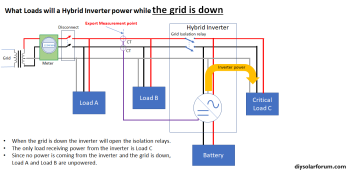Can this be used to do download the firmware? ksmithaz1 had mentioned it and I saw something he did somewhere regarding this.
Coupla times in the summer. You have to format a fat16 usb stick like 8g or 4g. Extract
The phase shift should not be an issue if the inverter is working properly. The inverter will sense the grid is available and start adjusting the frequency and phase till it matches the grid. (This can take several seconds) Only then will it close its relays to reconnect to the grid.
On the load side the frequency and phase shift will be slow and should not affect anything.
Mostly what I was alluding to. If you soft-switch to the grid which is tied to the inverter and you are using the "load" lugs, you will be fine. This is the scenario above. If your panel is nailed to the grid lugs, and you are driving the load and you flip on a breaker that simply throws grid power at the same connections it will work, but may give you grief. It might go bang kinda loudly depending on what's running, it might pop some breakers. You could momentarily be out of phase as much as 180 degrees producing a 480V potential between the inverter and the grid. The same is true from the load perspective if you run a transfer switch as inverter primary and grid secondary to load common. This is a break/switch scenario, but your electric devices could see a 180 degree instantaneous polarity reversal, which will cause a significant albeit brief surges. This would not feed back to the inverter at that point, but when you switch back.... Now if your switch time is fairly long (>100ms) it won't matter much.
So Yes/No/Maybe. Depends on how your wired.
Grab a scope or meter. We'll assume your neutral is shared, it becomes the reference point. While disconnected completely from the grid, Put one lead on an inverter leg the other on a grid leg, watch the voltage float around as the outputs float in and out of phase. If you have a scope put common to neutral, and connect a probe to l1 on the inverter and to l1 on the grid, watch the waves float in and out of sync. Now connect the grid to the inverter grid, the inverter will sync up and the waves will oscillate in lock step. Pretty cool actually, but that is what the three second delay is about. If your panel is wired in parallel with your inverter and the grid, and you don't keep it on all the time, ... As soon as the grid comes back you are likely to have a rapid phase shift.
Did that explain the issue? It's not a catastrophic thing, but can cause disruptions and issues. The power company may actually do this to you from time to time as it shifts loads around across town. I'm sure you've noticed a scary brown out or two that made a lot of noise with your appliances and/or AC.



